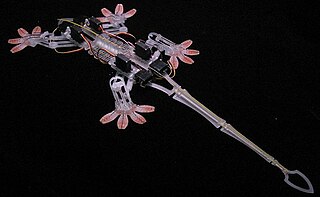
Microbotics is the field of miniature robotics, in particular mobile robots with characteristic dimensions less than 1 mm. The term can also be used for robots capable of handling micrometer size components.

Bionics or biologically inspired engineering is the application of biological methods and systems found in nature to the study and design engineering systems and modern technology.

Dario Floreano is a Swiss-Italian roboticist and engineer. He is Director of the Laboratory of Intelligent System (LIS) at the École Polytechnique Fédérale de Lausanne in Switzerland and was the founding director of the Swiss National Centre of Competence in Research (NCCR) Robotics.

Koç University is a non-profit private university in Istanbul, Turkey. It started education in temporary buildings in İstinye in 1993, and moved to its current Rumelifeneri campus near Sarıyer in 2000. Koç University is ranked highest in Turkey according to the 2022 Times Higher Education World University Rankings and 2022 QS World University Rankings. Koç University currently consists of Colleges of Social Sciences and Humanities, Administrative Sciences and Economics, Science, Engineering, Law, Nursing and Medicine. Koç University offers 22 undergraduate, 29 graduate and 30 PhD programs. The university is home to around 7,000 students. The university accepts international students from various countries and has an extensive network of over 250 partner-universities including University of California and other universities such as Northwestern University, Cornell University and Georgetown University.

Synthetic setae emulate the setae found on the toes of a gecko and scientific research in this area is driven towards the development of dry adhesives. Geckos have no difficulty mastering vertical walls and are apparently capable of adhering themselves to just about any surface. The five-toed feet of a gecko are covered with elastic hairs called setae and the ends of these hairs are split into nanoscale structures called spatulae. The sheer abundance and proximity to the surface of these spatulae make it sufficient for van der Waals forces alone to provide the required adhesive strength. Following the discovery of the gecko's adhesion mechanism in 2002, which is based on van der Waals forces, biomimetic adhesives have become the topic of a major research effort. These developments are poised to yield families of novel adhesive materials with superior properties which are likely to find uses in industries ranging from defense and nanotechnology to healthcare and sport.

Founded on 18 March 2011, the Max Planck Institute for Intelligent Systems (MPI-IS) is one of the 86 research institutes of the Max Planck Society. With locations in Stuttgart and Tübingen, it combines interdisciplinary research in the growing field of intelligent systems. Intelligent systems are becoming increasingly important in many areas of life – as virtual systems on the Internet or as cyber-physical systems in the physical world. Artificial intelligent systems can be used in a broad range of areas, for instance in autonomous vehicles or to diagnose and fight diseases.
The following outline is provided as an overview of and topical guide to robotics:

The Jet Propulsion Laboratory Science Division investigates physical and chemical processes on the Earth, in the Solar System, and throughout the universe. Explorations of space and terrestrial processes lead to understanding of the universe. Methods for accomplishing scientific work pertaining to the nature of the Earth, the Solar System, the galaxy, etc., are addressed in the JPL Science Division. Techniques in both physical and life sciences are utilized.

Bio-inspired robotic locomotion is a fairly new subcategory of bio-inspired design. It is about learning concepts from nature and applying them to the design of real-world engineered systems. More specifically, this field is about making robots that are inspired by biological systems, including Biomimicry. Biomimicry is copying from nature while bio-inspired design is learning from nature and making a mechanism that is simpler and more effective than the system observed in nature. Biomimicry has led to the development of a different branch of robotics called soft robotics. The biological systems have been optimized for specific tasks according to their habitat. However, they are multifunctional and are not designed for only one specific functionality. Bio-inspired robotics is about studying biological systems, and looking for the mechanisms that may solve a problem in the engineering field. The designer should then try to simplify and enhance that mechanism for the specific task of interest. Bio-inspired roboticists are usually interested in biosensors, bioactuators, or biomaterials. Most of the robots have some type of locomotion system. Thus, in this article different modes of animal locomotion and few examples of the corresponding bio-inspired robots are introduced.

Jeffrey Karp is a Canadian biomedical engineer working as a Professor of Medicine at Harvard Medical School, Brigham and Women's Hospital, and the principal faculty at the Harvard Stem Cell Institute and Affiliate Faculty at the Massachusetts Institute of Technology through the Harvard–MIT Division of Health Sciences and Technology. He is also an affiliate faculty at the Broad Institute.

Arthropods, including insects and spiders, make use of smooth adhesive pads as well as hairy pads for climbing and locomotion along non-horizontal surfaces. Both types of pads in insects make use of liquid secretions and are considered 'wet'. Dry adhesive mechanisms primarily rely on Van der Waals' forces and are also used by organisms other than insects. The fluid provides capillary and viscous adhesion and appears to be present in all insect adhesive pads. Little is known about the chemical properties of the adhesive fluids and the ultrastructure of the fluid-producing cells is currently not extensively studied. Additionally, both hairy and smooth types of adhesion have evolved separately numerous times in insects. Few comparative studies between the two types of adhesion mechanisms have been done and there is a lack of information regarding the forces that can be supported by these systems in insects. Additionally, tree frogs and some mammals such as the arboreal possum and bats also make use of smooth adhesive pads. The use of adhesive pads for locomotion across non-horizontal surfaces is a trait that evolved separately in different species, making it an example of convergent evolution. The power of adhesion allows these organisms to be able to climb on almost any substance.

Jong-Oh Park is a South Korean robotics scholar. He is President of the Korea Institute of Medical Microrobotics and Robot Research Initiative. He joined the faculty of the school of Mechanical System Engineering at the Chonnam National University in South Korea, and presently serves as an executive board member at the International Federation of Robotics (IFR). He has twice received the Scientist of The Year Prize from the Korea Science Reporters Association, and is also the recipient of the IFR's Golden Robot Award, among many other honours. He has also successfully commercialized several robotic systems for medical and industrial applications.

Robot Research Initiative (RRI) is a research institute dedicated to advanced robotics research. It is an affiliated organization of Chonnam National University in Gwangju, Republic of Korea. Prof. Jong Oh Park moved from the Korea Institute of Science and Technology to Chonnam National University in early 2005 and established RRI in March 2008, where he is still actively in charge. RRI is currently a leading institute in the medical robotics field, especially in the area of biomedical micro/nano robotics. RRI is one of the largest institutions among university robotics laboratories in Korea and competes globally.
Bradley James Nelson is an American roboticist and entrepreneur. He has been the Professor of Robotics and Intelligent Systems at ETH Zurich since 2002 and is known for his research in microrobotics, nanorobotics, and medical robotics.

Soft robotics is a subfield of robotics that concerns the design, control, and fabrication of robots composed of compliant materials, instead of rigid links. In contrast to rigid-bodied robots built from metals, ceramics and hard plastics, the compliance of soft robots can improve their safety when working in close contact with humans.

A robot fish is a type of bionic robot that has the shape and locomotion of a living fish. Most robot fish are designed to emulate living fish which use body-caudal fin (BCF) propulsion, and can be divided into three categories: single joint (SJ), multi-joint (MJ) and smart material-based "soft-body" design.
Peer Fischer is a German robotics researcher, specializing in biological nanorobotics.

A biohybrid microswimmer also known as biohybrid nanorobot, can be defined as a microswimmer that consist of both biological and artificial constituents, for instance, one or several living microorganisms attached to one or various synthetic parts.

A microswimmer is a microscopic object with the ability to move in a fluid environment. Natural microswimmers are found everywhere in the natural world as biological microorganisms, such as bacteria, archaea, protists, sperm and microanimals. Since the turn of the millennium there has been increasing interest in manufacturing synthetic and biohybrid microswimmers. Although only two decades have passed since their emergence, they have already shown promise for various biomedical and environmental applications.
Ho-Young Kim is a mechanical engineer and an academic. He is a Professor and chair in the Department of Mechanical Engineering at Seoul National University.















